
|
Back to |
| The Front Page |
| The Game |
|
Playing Gateball in Japan |
|
by Paul Salisbury photos by Sue Leitinger and Paul Salisbury layout by Reuben Edwards Posted January 19, 2009
|
As a transplanted British croquet player living and working in Japan, it was only natural that Paul Salisbury should develop an interest in the hoop-and-ball game played by millions in the far east and now spreading throughout the world. We asked him for his personal take on the game, based on his experience of finding a club in Japan and playing there regularly. Would he play gateball if there were a croquet club handy? We were too polite to ask. Alex Park is another matter: he is spreading the word to croquet clubs in the West and recommending to club managers that they include the scaled-down variant in their lawn programs.
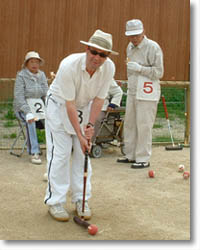
|
| Paul Salisbury poses for his starting shot with the local Nagoya club. At the age of 50, he's by far the youngest player. |
Morning Gateball in Nagoya
In my city - Nagoya - we play in the mornings most days from 8.30 to 10.15. We play two games of 25 or 30 minutes each, which we rarely finish to the peg, have a tea break, then play a final game. We play on dirt, at two different locations. One is used in the summer because it is under the expressway and therefore in the shade.
Pet owners tend to walk their dogs over our court and leave footprints, which we have to brush away before the start of play. I've suggested they put up a sign requesting owners to keep their dogs off, but I think my fellow gateballers are too polite for that. I've been to six different gateball locations in Japan and never seen it played on grass yet, although I know major competitions tend to be played on grass.
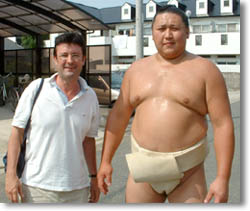
|
| Among the morning activities filling the streets, parks, and shrines of Nagoya are gateball and sumo wrestling. Can you tell which figure is our author and which is the wrestler in this snapshot? |
I joined without hesitation upon hearing that the fee is a dollar a month (even if the exchange rate moves against me, I reckon I'll be okay) and they gave me a members list typed up in Japanese. Only the other day the captain asked me, "Paul san, can you read kanji?" I answered, "Not much," so he said in an amazed voice, "Then, you don't know our names, do you?" To which I replied weakly, "Well, it's not a problem, my Japanese isn't good enough to talk about any of you." I daren't admit I don't even know the name of the club!
One of my Japanese teachers, who speaks a little English, has also joined the club, so I can now ask about tactics (or the name of the club). She told me that one of the members said, "Paul's on our club team and he doesn't even know the rules!"
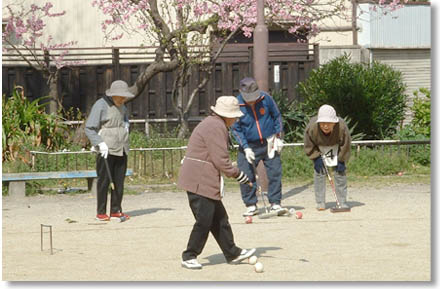
|
| During the week of "sakura", Japanese people in hordes head for parks to have picnics, drink and celebrate the cherry blossoms of spring. The gateballers play gateball beneath pink flowers that will fall to earth within days. |
Gateball's appeal for croquet players
There's a substantial skills overlap for Association Croquet and Golf Croquet players (including hoop running and 'hitting in'), but in addition, there is a strong element of team tactics not present in conventional croquet.
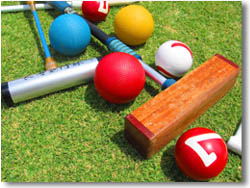
|
| Gateball equipment is smaller and lighter and can be bought for much less than equivalent croquet gear. |
The control of the position of the striker's ball after a roquet, much like the control of the cue ball in snooker, is another skill for novice gateball players to master. So you find yourself attempting to hit the edge of a ball (like a cut rush) to get striker's ball to near others balls which you may then hit and "spark."
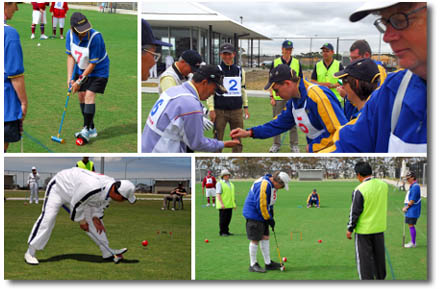
|
| After the coin-toss, the Australia Gateball National Championship in May 2008 at the 12-lawn Victoria Croquet Centre in Melbourne featured plenty of "sparking" - the equivalent to the croquet stoke. Croquet Australia has adopted a progressive posture towards "lessor" games by sponsoring the development of gateball on their continent. Croquet Australia has begun to position croquet as only one of many "malletsports." |
You can make a big impression on spectators by sparking one opponent ball into another opponent ball near the boundary to put them both out. Cannons and bombardments are fair lines of play, and with 10 balls on the lawn, the tactical possibilities are rich. Apply your imagination, and the possibilities are virtually endless.
A matter of style: side stance or centre stance
As an established croquet player who has taken up gateball recently, I play "centre style" because I'm accustomed to it; it's the way I've always played and it works for croquet. All the Japanese play "side style" and are fascinated by my style, especially when I play well. Experienced gateball players sometimes try to use it, but generally they can't seem to adapt to centre style and get frustrated and mutter something like, "Eeeeeeeehhh! it's difficult," and revert to side style.
I have heard that the Brazilians also use centre style, but I can't confirm that by personal observation. The results of some kind of controlled study would be most interesting, to compare the utility of side style versus centre style in gateball. The ergonomics of croquet, with its heavier equipment, argue strongly for the gravity-controlled pendulum stroke; however, with lighter mallets and balls, striking the ball from the side might actually prove to be as good or better for gateball than the centre style croquet stroke.
Time constraints are never a problem
While there is a ten-second time limit on playing your shot, it is not a problem because there are nine other people playing before you so you've plenty of time to get to a position at the edge of the court nearest to your ball. The players do not have to consider "thinking" about the shot, because the final choice of shot is up to the team caption, at all times. All the player has to do is to execute - which explains how I've become a reasonably effective gateball player without mastering the rules and tactics. So I've yet to encounter a problem with time constraints. Rest assured, there's nothing in gateball comparable to the running around that takes place in croquet's "speed doubles" or "10:10 games."
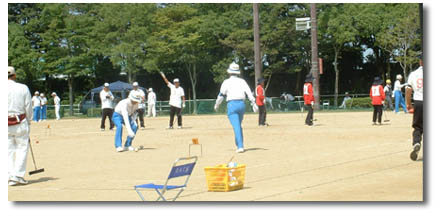
|
| The local prefectural championship is equivalent to a county championship. Even these events may be played on non-grass surfaces. |
Also, there is no need for courtside signage of any kind to keep track of the status of the game because each player is allowed to have his own electronic scorekeeper for all balls in the game, worn like a wristwatch.
What you have to do to win
To win, you must get your team's balls through all three hoops and pegged out before the opposition can do it. There are two teams of five players each, with numbered balls. One team plays with odd numbered red balls (1,3,5,7 and 9), and the other with white, even numbered balls (2,4,6, 8, and 10). Each player wears a bib emblazoned with the number of his ball. The balls are played in strict numerical sequence, which gives rise to tactics such as sending your team's ball #3 close to the opposition's ball #4 because #3 plays before #4 and will be able to hit #4 and "spark" it off the court or use it in some other manner. (This is another similarity to American Rules play, as in "feeding your partner a break.")
The tournaments are community spectacles
I played recently in a minor tournament held in a local park. The opening ceremony, very Japanese and formal, began with local government officials making speeches and taking a few ceremonial shots - usually failing to run hoop one.
Before each game, we all lined up as in a presentation ceremony, in number order (your bib shows the number of your ball), at our starting location. At the end of the tournament there were more speeches and plenty of bowing.
The most notable part of tournaments in Japan is the sheer number of referees; you don't have to stand around with your mallet raised waiting for one to come from four lawns away. They are everywhere, at least three permanently based on each lawn. They give a running commentary of the game, in Japanese - so of course I have no idea what is being said.
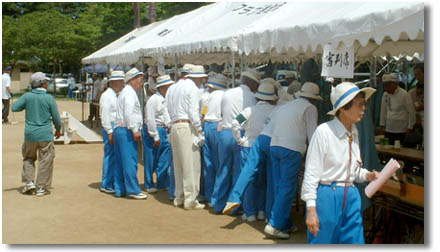
|
| In all gateball tournaments, there are referees in great abundance, easily spotted by the blue pants they are required to wear. |
Here's a Japanese gateball joke: "Don't suppose you've seen a ref, by any chance, have you, mate?" The answer is, "There should be one along any year now, I believe they wear blue trousers, if you're lucky enough to spot one!" In truth, they're ubiquitous; you can't miss them.
The game is wildly popular and spreading fast
At the 2006 World Championships in Korea there were 96 teams from 13 countries and more than 2000 participants, including players, refs, officials and organisers. Japan, Korea and China were the main contenders.
Big tournaments are played in stadiums in Japan and South America, because there are so many participants.
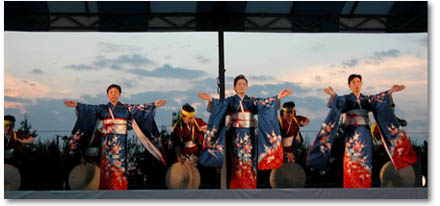
|
| The last gateball world championship in Japan was held in Toyama in 2002, with the opening ceremonies featuring colorful displays of local culture. The 2006 championship was in Korea, and China hosts the next one, in 2010. Photo by Lowen Clarke |
Just as in croquet, traveling teams tend to be composed of older people, who have the leisure and funds needed to travel and compete. And just as in croquet, the teams that win the Championships tend to be composed of younger players.
Although the sport is played by millions worldwide, it is most popular in Asia and South America. With it's rapid growth, that picture is likely to change dramatically in the 21st Century.
The next world championship, held very four years, is in China in October 2010. There's never been any European representation, so far. Some organizers will try hard to heighten interest in the game in the West, sufficient to produce teams to compete in one of the forthcoming events.
The spread of gateball is unstoppable, inevitable. Croquet players really DO come with an advantage when taking up the game. So, my message to players in the West is: "You may well be 'AC/GC' but are you 'GB?'"
|
How to play gateball at your croquet club Gateball offers a great opportunity for croquet clubs interested in expanding their offer for current members and attracting new members. Existing members will have the satisfaction of finding themselves very good at a new sport in a short space of time because of the technical similarities between the games. Nevertheless, mastering the strategy will prove an exciting challenge for even the most seasoned croquet players. New players will be attracted because the game is social (two teams of 1-5 players) and takes only thirty minutes to complete. Croquet lawns are ideal for gateball and often amaze gateballers from Japan used to playing on dirt or long-grass courts. A single croquet lawn can accommodate two gateball courts (with up to twenty players), meaning there is always room for plenty of gateball even at the busiest croquet facilities. Courts are usually marked out using tape or string, so there is no need to paint new lines in order to play. Gateball equipment is inexpensive compared to croquet equipment and easy to buy. Because it is mass produced, a full set of gateball equipment including tape for marking out the court, gates, balls and a set of ten mallets, costs around £350 (US$500). This cost can be further reduced by marking out the court with string, making your own gates (they don't need to be as solid as croquet hoops) or sharing mallets (you need no more than four to get started). The easiest way to purchase equipment is to order it online from one of the two equipment suppliers that serve English-speaking customers: Sunshine Ace in Japan or the Hong Kong Gateball Association. The rules of the game are available on the World Gateball Union's website. While the rulebook may look imposing, players need to know only a handful of basic rules to start playing. The most complex section of the rules deals with the fouls that a player can commit while sparking, which can be introduced to the game as you become more serious. (Sparking is the gateball equivalent of the croquet stroke.) If you have any more questions about gateball, you can reference plenty of resources in English on the Internet. In addition to the rules, the World Gateball Union's website includes tips for improving your gateball technique and strategy, as well as news about gateball around the world. The Gateball Australia and UK Gateball websites also have plenty of information about the game, including results and photos from local events. Polyglots may also wish to visit the websites of Brazilian, Chinese, Japanese and Korean gateball associations! |
Alex Park, a member of the last Australian world championship gateball team, is studying in London until July 2009. He will be happy to provide free demonstrations at croquet clubs, by request. Alex will bring all the equipment you need and has tape to mark out courts. Don't forget: you can fit two gateball courts onto a single croquet court so it won't take up much space even if you've got a busy winter schedule. For further details or to arrange a visit to your club in the UK, email Alex at info@gateball.org.uk. If you're somewhere else in the world, Alex will try to direct you to the best resource for helping you try out gateball.